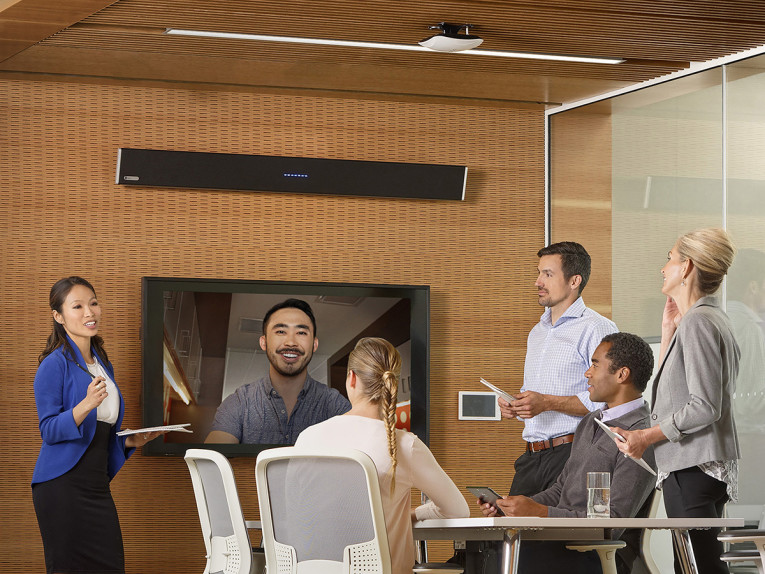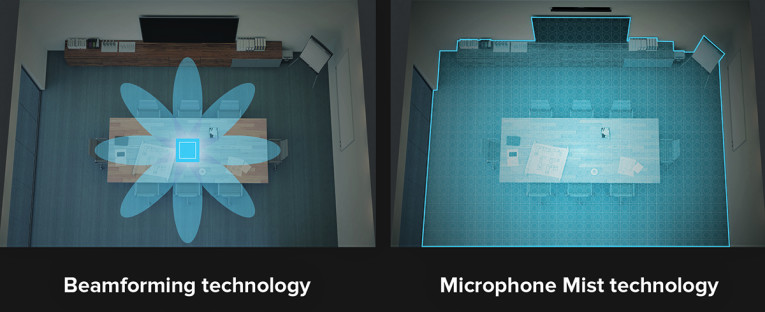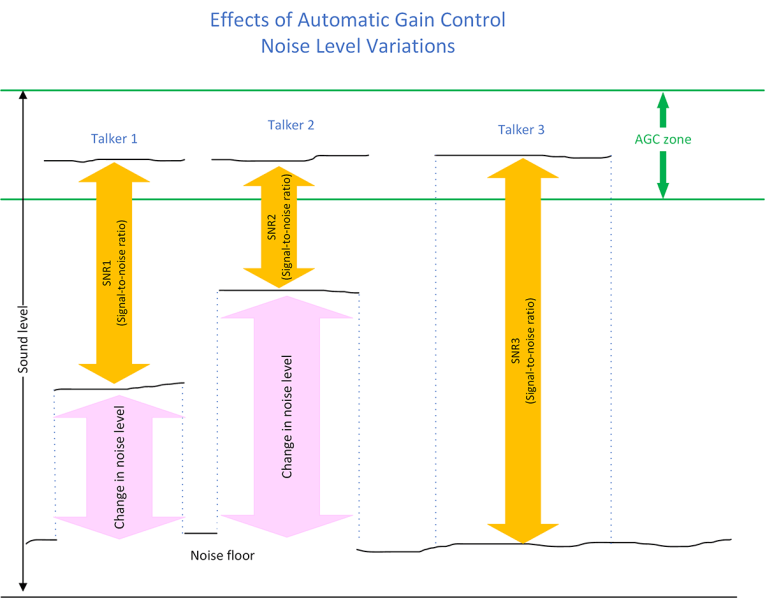
Let’s face it, conference calls don’t get much love. Quite the opposite, often. Why? Could it be that the remote person isn’t really paying attention? A Harvard Business Review study reveals that 65% of conference callers are doing other work, 55% are making or eating food, and 47% are going to the bathroom.
For onsite people, it might be having to sit still at the table and only speak facing forward as though they were still in grade school (what if you want to work at a whiteboard or just stretch your legs while you’re talking?). Constantly being asked to repeat yourself or enunciate more clearly is also extremely tiresome.
But for remote team members, the thing they probably don’t like the most about conference calls — and actually find extremely annoying — is how they sound. In any event, this is an audio magazine so that’s what we’ll concentrate on (and leave pondering people’s on-call bathroom habits to the folks at Harvard).
The Effects of Annoying Audio
That feeling of annoyance that many people associate with conference calls is more than just, well, annoying. Bad audio on a conference call (and video calls, too) can make it hard to concentrate and lead to listener fatigue. These effects can inhibit collaboration, clarity, and even morale. Then there is just not hearing people clearly. Misheard words can be costly.
There are also proven physiological effects. Scientific American points to studies showing that the negative effects are real. Recent research suggests that “noise-induced” stress caused by annoying sounds can affect the way we think. It can decrease the availability of dopamine in the prefrontal cortex to primary brain functions that ultimately may affect memory and learning.
What’s So Annoying about Conference Call Audio?
Why can listening to a person on a typical conference call be annoying, when talking in person is not (for most people)? Why don’t conference calls feel “natural”? There are a range of factors, like abrupt changes in volume (this happens a lot when a caller is on a cell phone) and audio that can sound tinny or echoey. But one of the most significant factors is background ambient sounds, which are sounds that are heard as background noise as well as any electronic hiss behind a talker’s voice on a call. Ambient sounds can interfere with the overall audio experience and the ability to clearly hear a caller.
Here, we are interested in how a given audio conferencing system handles these sounds. This, in turn, becomes the story of automatic gain control (AGC), which is used in most traditional conference call systems, versus position-based gain control (PBGC), which is a new technology found only in Nureva audio conferencing systems. Let’s look at how each works and the ramifications for users.


The purpose of AGC in an audio conferencing system is to keep the audio output level (what the remote person hears) within a targeted minimum-maximum range (set by the system microphone level control). It does this by adding more gain (boosting the signal strength) on quiet talkers and, possibly, reducing the gain on the signal from loud talkers.
This is fine as far as it goes, but there is a problem. The input of an AGC module/circuit treats the audio signal holistically. This means that if the AGC module is required to increase the gain of the audio signal, the whole signal has gain applied to it. This results in the talker and ambient noise being increased equally (see Figure 1).
Loud, Quiet, Loud, Quiet: Another AGC Issue
During a conversation with people in the same room (no mics involved), ambient noises are fairly constant. Psychoacoustics shows us how our brains adapt to these background noises. We concentrate on the person talking and filter out the background noises. We can think of this as a “natural listening experience.” But with AGC raising the level of the talker and the ambient noise, we get audio moments that are loud (when people are talking and gain is added) followed by moments that are quiet (when no one is talking and no gain is added).
Remote participants might experience the talker staying at the same level (target range) while the ambient noise is heard as increasing or decreasing as the AGC works to maintain a constant talker level for remote participants. This is referred to as “noise pumping” of the AGC module — with the signal-to-noise ratio (SNR) maintained at the original input signal. This pumping effect can be very noticeable and can be a contributing factor to poor sound quality — which may result in listener fatigue and distraction and a less pleasant experience overall.
Extra processing (including from filters and noise reduction circuits, etc.) is typically required to handle the increase in ambient noise that goes along with the increase in talker volume. This may also result in degradation of sound quality.

A New Approach to Audio Conferencing
“Can you speak up?”
“Can you repeat that?”
“Please move closer to the mic.”
How often do you hear requests and comments like these on conference calls? Whether they are caused by AGC or not, solving these issues is what motivated Nureva to develop its own audio conferencing systems. And knowing that traditional conference call systems just employed incremental improvements on mature technology, we decided to tackle the problem of bad conference call audio with a completely new approach.
The Microphone Mist Technology Revolution
After two years of blue-sky thinking and intense research and development, our team of scientists and audio engineers came up with a revolutionary concept we call Microphone Mist technology. Unlike traditional beamforming technology that steers pickup to just a few defined areas of a space and leaves dead zones where people can’t be heard, Microphone Mist technology fills a room with thousands of virtual microphones (see Figure 2) so people can be heard no matter where they move in a space or which way they face.
A virtual microphone is an individual “pickup point” created when two or more physical microphones work together through proprietary processing algorithms to focus their pickup patterns on a configurable zone.
Thanks to advanced processing power, Microphone Mist technology listens to each virtual microphone (essentially, the “positions” in PBGC) simultaneously and zeros in on the predominant sounds (talkers, typically), optimizing them for clear conversations. You can see the difference between the pickup patterns of traditional beamforming technology and Microphone Mist technology in Figure 3.

A New Paradigm: Position-Based Gain Control
This ability to zero in on sounds creates a number of benefits (more on them later in the article), but one of the most significant is enabling PBGC.
Microphone Mist technology focuses on the predominant sounds you want to hear (talkers) while maintaining a relatively constant background/ambient noise experience, optimizing the audio output. This is accomplished through patented algorithms that utilize the measured talker position to determine the correct gain processing strategy (algorithm) that increases the talker level, while maintaining constant ambient noise performance.
The result is an increase in SNR that directly translates into a less fatiguing and distracting remote listener experience.
Typical AGC circuits rely on heuristics and expert logic to determine how and when they should apply or decrease gain. An AGC circuit does not know how far away a talker is from the mic, so all signals — good and bad — are treated equally. Since Microphone Mist technology knows the talker’s position, the PBGC module can make specific optimizations to the microphone system and processing of the signal that other systems without positional information cannot (see Figure 4). These patented proprietary processes enable Nureva to optimize the talker gain while keeping ambient noise constant.

Natural Listening Experiences
The result is a “natural listening experience” for remote participants. They feel like they are in the room with their teammates—with a natural mix of voices and ambient noises. This makes conference calls far less annoying and fatiguing.
To be honest, we had a bit of a chuckle here at Nureva when a competitor published a blog telling users how they had to change their behaviors — like not moving around the room and not speaking away from the mic array — to get adequate conference call audio. We think asking the user to adapt to technology is exactly backward. It’s also far from “natural.”
With Nureva audio conferencing, the technology adapts to users, so they are free to move about work spaces, face in any direction, and even talk at the same time. And they can speak in normal conversational voices and still be clearly heard by the remote caller. Definitely more natural.
Advanced Ways to Eliminate Unwanted Sounds
We have also seen others in the industry who ask users to remove or keep ambient noise low — which is somewhere between difficult and impossible. How do you turn off the fan in a system with programmed climate control? This is why Nureva developed technology, called intelligent sound targeting (IST), which enhances our systems’ ability to diminish the annoyance of unwanted noises.
While traditional systems try to deal with unwanted sounds using “post-sound” filters that require substantial processing resources to suppress sounds, IST in our Microphone Mist technology takes a “pre-sound” approach. Using adaptive learning algorithms, IST preemptively identifies and learns unwanted persistent sounds and then simply stops picking them up. This is only possible because of Microphone Mist technology’s ability to listen to, and delineate, those thousands of virtual microphones.
Are you seeing a pattern here? Another audio conferencing situation that suffers from extraneous noises is a presentation in front of a large group, such as a lecture. Here the main culprit is chatter and other noises from the audience or class. To solve this, Nureva developed an extension called Active Zone Control that can really make a difference for remote students or those viewing a class later through lecture capture.
Active Zone Control enables the presenter or IT to use a simple interface to define the pickup zone in a space. Pickup can be focused on the area where the presenter will move at the front of the room while pickup from the virtual mics in the rest of the space is sharply diminished. Bonus: the presenter gets isolated voice pickup without the hassle of a lapel mic or headset.
Now Hear the Difference
We began this article by noting the potential for real negative effects from bad conference call audio, especially from annoying ambient sounds. As we’ve shown, new technology has the potential to mitigate these effects and help team members on both ends of a conference call have a more natural listening (and speaking) experience.
You can visit Nureva.com to learn more about Microphone Mist technology and our line of audio conferencing systems. But best of all, we have such confidence in the performance of our technology, we offer live online demos (we are one of the few audio conferencing solution providers to do this) so you can hear the difference a natural listening experience makes. aX
This article was originally published in audioXpress, February 2020







